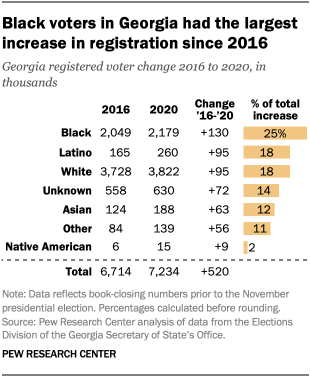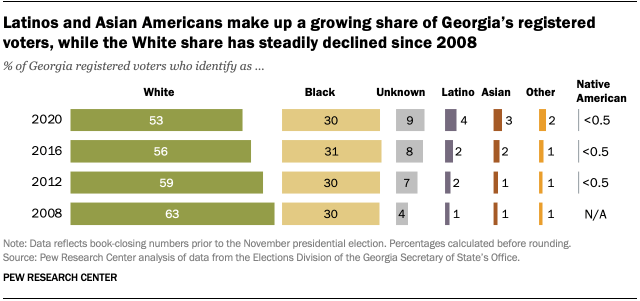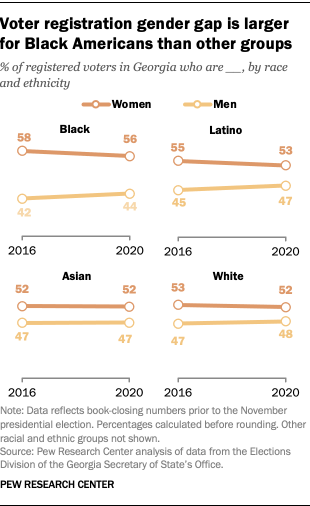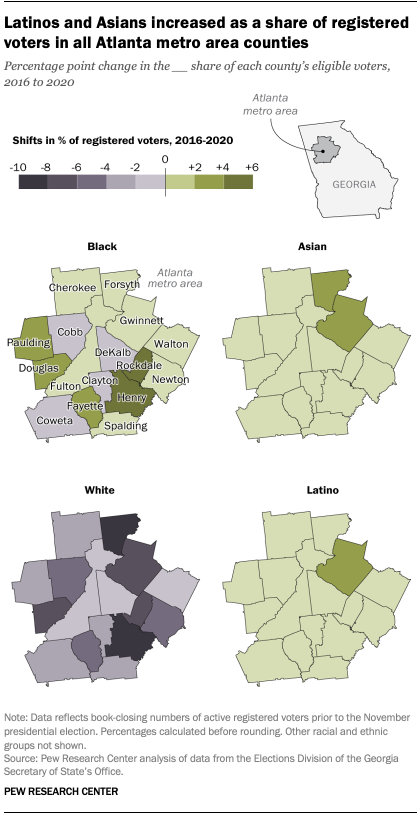Following Joe Biden’s narrow presidential win in Georgia, early voting is underway in the state’s Jan. 5 runoff election for two U.S. Senate seats, races that will determine whether both chambers of Congress are led by Democrats during the first years of the new administration. Once a reliably Republican state, Georgia has received much attention for the increasing racial and ethnic diversity of eligible voters in the state, which has highlighted the importance of Black voters and other fast-growing groups like Latino and Asian voters.
The number of Black registered voters in Georgia increased by about 130,000 between Oct. 11, 2016, and Oct. 5, 2020, the largest increase among all major racial and ethnic groups, according to a Pew Research Center analysis of Georgia Secretary of State’s Office data. Meanwhile, early reports suggest that turnout in November 2020 among Black registered voters increased compared with 2016, but not as much as other groups.
The increase of 520,000 in new registered voters in Georgia since 2016 came from a variety of sources, as no single racial or ethnic group accounted for more than 25% of the newly registered. Even so, some groups of registered voters saw larger increases than others, shifting the overall racial and ethnic composition of registered voters.
For this report, which looks at the makeup of the Georgia electorate in advance of the state’s two U.S. Senate seat runoffs on Jan. 5, we analyzed the number of registered voters as well as their race and ethnicity, gender, and county of residence, based on data from the Elections Division of the Georgia Secretary of State’s Office.
The 16 counties referenced as “central counties” in the analysis of the Atlanta metropolitan area are based on 2020 delineations from the U.S. Census Bureau.
The number of Latino and White registered voters increased by roughly the same amount, each by 95,000, despite there being far fewer Latino than White existing registered voters (260,000 vs. 3.8 million). The number of Asian registered voters increased by 63,000, a substantial amount relative to the group’s Oct. 5, 2020, total (188,000).
Related: Black eligible voters have accounted for nearly half of Georgia electorate’s growth since 2000
Roughly 72,000 newly registered voters (14%) did not disclose their race or ethnicity, while 56,000 (11% of newly registered voters) identify with other racial and ethnic groups. The number of Native American registered voters more than doubled from 6,000 in 2016 to 15,000 in 2020.
In addition, roughly 76,000 new voters have reportedly registered between the presidential election Oct. 5 deadline and the Dec. 7 U.S. Senate runoff registration deadline. Fewer than half (46%) of these new voters identified themselves as White.
White registered voters remain the largest group among all Georgians registered to vote, making up 53% in 2020 – down from 63% just before the 2008 election. Meanwhile, Black registered voters make up 30% of the state’s registered voters, little changed since 2008.
While Latino and Asian registered voters each make up relatively small shares of voters on Georgia’s rolls, 4% and 3% respectively, both groups have grown rapidly. In 2008, each group made up only 1% of Georgia voters. The share of those who did not disclose their race or ethnicity increased from 4% to 9% during this time.
As was the case with the rest of the nation, Georgia’s turnout among registered voters was up in November (69%) compared with 2016 (62%). However, turnout in the state remained below the levels seen in the 2012 and 2008 presidential elections.
Women make up a majority of registered voters across major racial and ethnic groups, particularly among Black voters
Women make up a majority (53%) of Georgia’s registered voters. However, gender differences are larger among Black and Latino voters than among White and Asian voters.
In 2020, more than half (56%) of Black registered voters are women while 44% are men. And even as women make up a larger share of voters than men across racial and ethnic groups, the difference is starkest among Black voters.
Among Latinos, women make up 53% of registered voters while men make up 47%. The gender balance among both Black and Latino registered voters is closer than it was in 2016.
Atlanta area has propelled Georgia’s growing diversity among registered voters
The Atlanta metropolitan area added 301,000 registered voters from 2016 to 2020 and accounted for a majority of the state’s increase (58%) during this time. Overall, the metro area’s 3.9 million registered voters account for 54% of the state’s registered voters in 2020. The Atlanta area, which had a turnout rate (70%) among registered voters, aided Biden’s win. This was due in large part to support in suburban areas that once reliably backed Republican presidential candidates.
All 16 central counties in the metro saw higher numbers of registered voters in 2020 than in 2016. Growth was greatest in Forsyth, Paulding and Cherokee counties, where voter registration numbers rose by 18%, 17% and 16% respectively over 2016. Gwinnett County, one of the metro’s most populated, also saw significant growth. It recorded 54,000 more registered voters in 2020 than in 2016 – a 10% increase.
Among major racial and ethnic groups in the Atlanta metro area, the number of Black registered voters increased the most between 2016 and 2020 – by 115,000, or 9%. Henry and Rockdale counties saw the largest increase in Black registered voters as a share of their voter rolls, both having risen by 6 percentage points to 45% and 54% respectively.
The number of Hispanic and Asian registered voters also increased significantly, especially relative to their population size in the metro area. There were 60% more Hispanic registered voters in 2020 compared with 2016, up from 106,000 to 170,000. The number of Asian registered voters in the Atlanta area grew by 55% over the same period, from 99,000 to 152,000. Growth among Hispanic and Asian registered voters was especially notable in Gwinnett county. As a share of the county’s electorate, Hispanics and Asians saw both their shares increase by 3 percentage points, to 9% and 10%. Meanwhile, the Black electorate rose by 1 point and the White electorate dropped by 7 points in the county.
White registered voters saw their shares drop in every central county in the metro area, but declines were most notable in Forsyth and Henry counties, where their shares dropped by 9 points and 8 points respectively.




